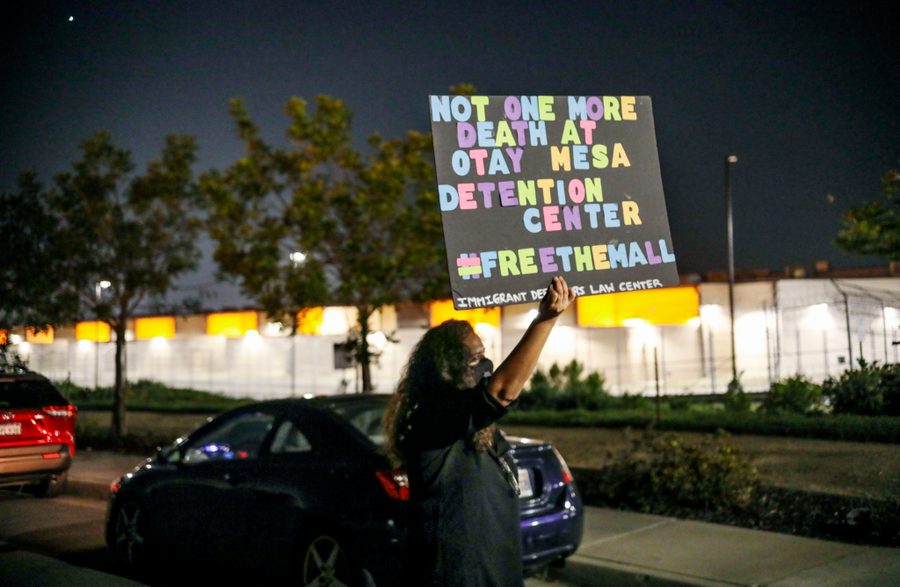Covid-19 Hunger Strikes Sweep Migrant Detention Centers
Jailed migrants are fighting a battle for their lives.
Maurizio Guerrero

TACOMA, WASH. — Despite the risks to his health amid the pandemic, Daniel López is languishing in immigrant detention because his presence makes money for the private prison company GEO Group.
“To them, we are just commodities for their business,” López, a 32-year-old immigrant from Baja California, Mexico, says. He is speaking from the Northwest Detention Center in Tacoma, Wash., a jail-like facility owned by GEO Group, the corporation that receives more taxpayer dollars for immigrant detention than any other Immigration and Customs Enforcement (ICE) contractor.
“We are forced to work here,” López says. “One dollar per day.” He describes it as a “trap.” The meals, often rotten, come in small portions; if detainees want to eat something else, they have to work to pay for it. “Everything they sell is overpriced,” López adds.
The potentially catastrophic impact of Covid-19 in jails has intensified the feeling of abuse among many detained immigrants. It has also spurred an uprising that mirrors growing political and social movements across the United States.
Nearly 2,500 people have joined Covid-19-related hunger strikes in detention centers nationwide since March, according to Detention Watch Network, a grassroots organization that demands the abolition of immigrant jails. By comparison, between 2015 and 2019, a total of 1,600 people in ICE detention went on hunger strike, according to Freedom for Immigrants.
In June, people detained at the Mesa Verde Detention Facility in Bakersfield, Calif. — operated by GEO—organized what Centro Legal de la Raza considers the first Black Lives Matter protest inside an ICE jail. According to Centro Legal, the legal services agency representing the strikers, immigrants endured a “corrupt and racist criminal justice system before being pushed into the hands of ICE.”
“All these struggles are connected,” says Deyci Carrillo López, a legal assistant at Centro Legal.
Nearly 70 detained people launched a seven-day hunger strike at the beginning of July to warn of the dangers of Covid-19 at Mesa Verde, after a nurse at the facility tested positive. (At least one person detained tested positive for the virus during the hunger strike.)
“I think [the detainees are] organizing [on] the inside and working with each other to see what next steps they can take to actually push GEO to listen to them,” Carrillo López says. “They are thinking about new strategies.”
Since early May, all women, and a number of vulnerable men, have been released from Mesa Verde. Overall, more than 1,400 migrants around the country have been released to avoid exposing them to Covid-19, according to ICE.
Yohanne Eugenio, a 38-year-old born in the Philippines, has been locked up in the Northwest Detention Center in Tacoma for 17 months. “I’ve lived in the United States for 35 years and I’ve never, ever been treated this way, even when I was incarcerated,” Eugenio says. “It’s like they do not care.”
Eugenio has a painful cough and worries she has Covid-19. She says her condition worsened after officers started using a strong disinfectant. Detention Watch Network (DWN) has identified the use of HDQ Neutral, a disinfectant known to cause bleeding, burns and pain, in ICE facilities.
ICE figures list 3 ‚731 total Covid-19 cases and three deaths among 22,405 detained people as of July 21. The Center for American Progress suggests those numbers could be grossly undercounted. As the crisis at San Quentin prison shows, an uncontrollable outbreak inside a jail is a real concern.
Relocations of people with Covid-19 have also spread the virus. The Farmville Detention Center in Virginia, with two Covid-19 cases in late April, experienced a surge after transfers of people from Arizona and Florida. As of July 21, Farmville is the hardest-hit immigration facility in the U.S., with 315 Covid-19 cases.
Bárbara Suarez Galeano, organizing director at DWN, compares the transfers to “biological warfare.” Those detained suffer “multiple levels of aggression and abuse piled onto each other,” she says.
ICE is “also known to use rubber bullets, pepper spray and brute force to harass, intimidate and subdue any organizing inside detention centers,” Suarez Galeano writes in a July 14 op-ed. Others have documented force-feeding and forced hydration in response to hunger strikers, methods considered inhumane by United Nations experts.
Resistance inside continues as corporations profit by keeping people in jail as long as possible.
“We need to be with our families, especially in times like these, when they could get sick,” Daniel López says. “If we were released, we would be able to help them. The biggest risk is keeping us here.”
Maurizio Guerrero is a journalist based in New York City. He covers migration, social justice movements and Latin America.









